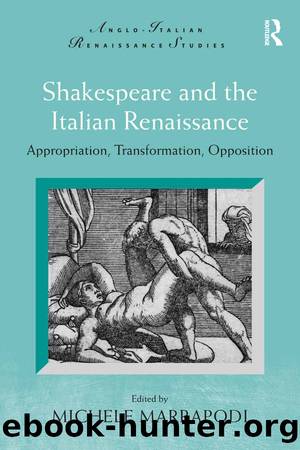Shakespeare and the Italian Renaissance by Marrapodi Michele; Marrapodi Professor Michele ;

Author:Marrapodi, Michele; Marrapodi, Professor Michele ;
Language: eng
Format: epub
Publisher: Taylor and Francis
Published: 2014-09-14T16:00:00+00:00
Chapter 11
“Dark is Light” – From Italy to England: Challenging Tradition through Colours
Camilla Caporicci
Renaissance English authors, and particularly Shakespeare, approached Italian culture with two contrasting attitudes. On the one hand, the immense Italian patrimony was felt as something stable, “finished”, a stone monument weighing on England’s developing culture. English authors had either a submissive response to this monument, resulting in imitation, or a contrary one that resulted in intentional deviation from the “model”, when not explicitly parodying it. On the other hand, Italy was not just something “past”, perceived as complete and ready to be observed, either in awe or with impatience, but something “in motion”. Italian influence on early modern England therefore emerges as an evolving and active force, continually generating a dialectical interchange in which the opposition to the dominant and static models was in turn part of an innovative current of thought to which Italy contributed.
My intention here is to analyze this dual influence through Shakespeare’s complex process of appropriation/opposition to Italian models, with a focus on the symbolic use of chromatic and luministic values. After illustrating the traditional European outlook, born in Italy, I will show how the colour symbolism associated with it was called into question, and then reversed, by the revolutionary works of Giordano Bruno and Caravaggio. These works will be seen as formulating a novel relationship between light and darkness in order to convey a new ontological and epistemological paradigm that broke with the hierarchical opposition of material and spiritual planes. I then consider Shakespeare’s peculiar use of colour and light imagery, demonstrating that, in opposing the traditional Italian model, the poet reveals himself to be embedded in that new chromatic sensibility, springing from a novel ontological matrix, that owes a great deal to Italy.
I begin with a brief illustration of the colour universe, born and fully structured in Italy, that by Shakespeare’s time had become orthodox throughout Renaissance Europe. Based on the binary opposition of white and black, light and darkness, this hierarchically structured universe reflected the Christian and Neoplatonic worldview developed in Italy, and formed the basis of most Italian and European artistic production.
The symbolism of Christian theology is at the core of the Renaissance chromatic paradigm. According to this symbolism, expressing a clearly dichotomous concept of creation, “white and black formed a pair of opposites and often represented the coloured expression of Good and Evil”.1 Light and the colour white represent God, Grace, the divine realm. Black, on the other hand, is not only the colour of Satan and of death, but of the whole post-lapsarian corrupt world, of the civitas hominis as opposed to the civitas dei. The Pauline separation of body and soul is also symbolized by metaphysical shades of colours, hierarchically organized: light, the only element of the sensible world both visible and immaterial, represents the spirit’s purity; black, being the denser colour, expresses the weight of matter and flesh – a flesh that is sinful in itself, mainly because of the carnal desire associated with it,
Download
This site does not store any files on its server. We only index and link to content provided by other sites. Please contact the content providers to delete copyright contents if any and email us, we'll remove relevant links or contents immediately.
The Power of Myth by Joseph Campbell & Bill Moyers(925)
Half Moon Bay by Jonathan Kellerman & Jesse Kellerman(911)
A Social History of the Media by Peter Burke & Peter Burke(879)
Inseparable by Emma Donoghue(844)
The Nets of Modernism: Henry James, Virginia Woolf, James Joyce, and Sigmund Freud by Maud Ellmann(738)
The Spike by Mark Humphries;(719)
A Theory of Narrative Drawing by Simon Grennan(706)
The Complete Correspondence 1928-1940 by Theodor W. Adorno & Walter Benjamin(703)
Ideology by Eagleton Terry;(659)
Bodies from the Library 3 by Tony Medawar(648)
Culture by Terry Eagleton(646)
World Philology by(645)
Farnsworth's Classical English Rhetoric by Ward Farnsworth(641)
A Reader’s Companion to J. D. Salinger’s The Catcher in the Rye by Peter Beidler(614)
Adam Smith by Jonathan Conlin(606)
Game of Thrones and Philosophy by William Irwin(592)
High Albania by M. Edith Durham(589)
Comic Genius: Portraits of Funny People by(581)
Monkey King by Wu Cheng'en(575)
